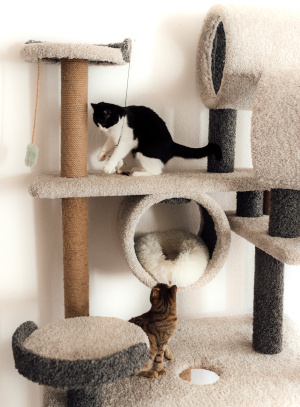
How well cats get along with each other is influenced by a range of factors related to the owner, the cats, the environment, and husbandry [1]. In some situations, cats may learn to get along. In other cases, they may not be compatible.
Planning and preparation
The success of an introduction depends largely on careful planning and preparation, including the following [2]:
- Socialisation — Preparation begins long before you bring a new cat home, with socialisation of your existing cat. Socialisation involves exposing animals to a range of experiences to help them prepare for and cope with different situations, interactions, and environments.
- Matching — When selecting your new cat, think about how well-matched they will be for your existing cat.
- Health checks — Make sure your cats have had recent health checks, and are up to date with their vaccinations, worming and external parasite control, so they are in the best shape to cope with the introduction process, and will not pose health risks to one another.
- Cat containment — Keeping a cat contained on your property is especially important for new cats who are unfamiliar with the area.
- Pheromone diffusers — Activating pheromone diffusers for a few days before bringing your new cat home, may help calm your existing cat and the new arrival.
- A transition space — Prepare a transition space where you can initially keep your new cat away from your existing cat(s). Make sure the space has everything they need (e.g. a comfortable bed, toys, scratching post, litter trays, food, water).
Bringing your new cat home
First, make sure your new cat is comfortable in their transition space. For more information see the Knowledgebase article ‘How do I help my cat adjust to a new home?’.
Gradual introduction
To maximise the chance that unfamiliar cats will get along, introduce them gradually, step by step. Observe your cats’ behaviour to see if you should proceed to the next step. Be prepared for the introduction process to take weeks to months [2].
Step 1: Scent swapping
Rub a towel over your existing cat and leave the towel in your new cat’s transition space. Rub a different towel over your new cat and leave that towel in your existing cat’s area. Repeat daily until your cats are comfortable with each other’s scent/a communal scent.
Step 2: Allow independent exploration
Allow them to explore each other’s areas of the home without the other present.
Step 3: Supervised visual contact
Allow short sessions of supervised visual contact behind a barrier (e.g., child gate or screen). If they are comfortable, gradually increase the duration of visual contact.
Step 4: Supervised free contact
If your cats seem comfortable going about their own activities behind a barrier, begin short, supervised sessions where the barrier is removed. Maintain separate resources, ensure they have their own areas to retreat to, and feed them separately. If they seem to get along, gradually increase supervised free contact sessions.
Step 5: Unsupervised free contact
Once your cats are comfortable with supervised free contact, gradually increase the amount of time they spend together unsupervised, and slowly phase out supervision.
Managing cat conflict
If persistent conflict occurs, seek advice from a vet or veterinary behaviourist. Separation, behaviour modification and potentially, medications, may be required at least in the short-term [3].
Good husbandry
To maximise the chance that cats will thrive together in the same household, it is necessary to practice good husbandry, including opportunities to engage in natural behaviours and stimulating activities. These behaviours and activities are not only fun but are also essential for animals’ physical and mental health. Providing each cat with quiet, private, safe spaces to retreat, hide, relax and toilet is also critical particularly in multi-cat households. One litter tray per cat plus an additional tray is highly recommended [3]. For more information on how to keep all the cats in your household happy and healthy, see the RSPCA Guide to Keeping Your Cat Safe at and Happy at Home.
References
[1] Finka LR, Foreman-Worsley R (2022) Are multi-cat homes more stressful? A critical review of the evidence associated with cat group size and wellbeing. J Feline Med Surg 24:65–76
[2] Horowitz D, Pike A (2016) Introducing a new cat into a household. Feline Behavioural Health and Welfare
[3] Clark C (2016) Dealing with multi-cat households: Management and treatment strategies. Companion Anim 21:68–74
